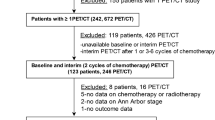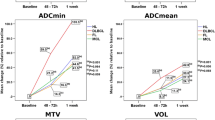Abstract
Objectives
To investigate the existence of quantum metabolic values in various subtypes of non-Hodgkin’s lymphoma (NHL).
Methods
Fifty-eight patients with newly diagnosed NHL and positron emission tomography (PET) performed within three months of biopsy were included. The standardized uptake value (SUV) from PET over the area of biopsy and serum glucose [Glc] were recorded. The group glucose sensitivity(G) for indolent and aggressive NHL was obtained by linear regression with ln(SUV) = G·ln[Glc] + C, where C is a constant for the group. Finally, the individual’s glucose sensitivity (g) was obtained by g = {ln(SUV)-C}/ln[Glc], along with their means in various subtypes of NHL. To further investigate the influence of extreme [Glc] conditions, the SUVs corrected by the individually calculated g at various glucose levels, [Glc′] using SUV′ =SUV·{[Glc′]/[Glc]}g, were compared to the original SUVs for both indolent and aggressive NHL.
Results
The averaged g (=G) for aggressive was significant different from that for indolent NHL (−0.94 ± 0.51 vs. +0.13 ± 0.10, respectively, p < 0.00005). There were significant differences in SUV for [Glc] < 80 or >110 mg/dl for both types of NHL. Unlike overlap among SUVs between NHL subtypes, the g value clearly categorized them into two distinct groups with positive (near-zero) and negative g values (around −1) for the indolent and aggressive NHLs, respectively.
Conclusions
Distinct quantum metabolic values of −1 and 0 were noted in NHL. Aggressive NHL has a more negative value (or higher glucose sensitivity) than that of indolent and, thus, is more susceptible to extreme glucose variation.



Similar content being viewed by others
References
Elstrom R, Guan L, Baker G, et al. (2003) Utility of FDG-PET scanning in lymphoma by WHO classification. Blood 101:3875–3876
Schoder H, Noy A, Gonen M, et al. (2005) Intensity of 18fluorodeoxyglucose uptake in positron emission tomography distinguishes between indolent and aggressive non-Hodgkin’s lymphoma. J Clin Oncol 23:4643–4651
Wong CY, Thie J, Parling-Lynch KJ, et al. (2005) Glucose-normalized standardized uptake value from (18)F-FDG PET in classifying lymphomas. J Nucl Med 46:1659–1663
Spaepen K, Stroobants S, Dupont P, et al. (2001) Prognostic value of positron emission tomography (PET) with fluorine-18 fluorodeoxyglucose ([18F]FDG) after first-line chemotherapy in non-Hodgkin’s lymphoma: is [18F]FDG-PET a valid alternative to conventional diagnostic methods? J Clin Oncol 19:414–419
Jerusalem G, Beguin Y, Fassotte MF, et al. (1999) Whole-body positron emission tomography using 18F-fluorodeoxyglucose for posttreatment evaluation in Hodgkin’s disease and non-Hodgkin’s lymphoma has higher diagnostic and prognostic value than classical computed tomography scan imaging. Blood 94:429–433
Weihrauch MR, Re D, Scheidhauer K, et al. (2001) Thoracic positron emission tomography using 18F-fluorodeoxyglucose for the evaluation of residual mediastinal Hodgkin disease. Blood 98:2930–2934
Mikhaeel NG, Timothy AR, O’Doherty MJ, Hain S, Maisey MN (2000) 18-FDG-PET as a prognostic indicator in the treatment of aggressive non-Hodgkin’s lymphoma: comparison with CT. Leuk Lymphoma 39:543–553
Kostakoglu L, Coleman M, Leonard JP, Kuji I, Zoe H, Goldsmith SJ (2002) PET predicts prognosis after 1 cycle of chemotherapy in aggressive lymphoma and Hodgkin’s disease. J Nucl Med 43:1018–1027
Spaepen K, Stroobants S, Dupont P, et al. (2002) Early restaging positron emission tomography with (18)F-fluorodeoxyglucose predicts outcome in patients with aggressive non-Hodgkin’s lymphoma. Ann Oncol 13:1356–1363
Fisher RI, Gaynor ER, Dahlberg S, et al. (1993) Comparison of a standard regimen (CHOP) with three intensive chemotherapy regimens for advanced non-Hodgkin’s lymphoma. N Engl J Med 328:1002–1006
Spaepen K, Stroobants S, Dupont P, et al. (2003) Prognostic value of pretransplantation positron emission tomography using fluorine 18-fluorodeoxyglucose in patients with aggressive lymphoma treated with high-dose chemotherapy and stem cell transplantation. Blood 102:53–59
Becherer A, Mitterbauer M, Jaeger U, et al. (2002) Positron emission tomography with [18F]2-fluoro-d-2-deoxyglucose (FDG-PET) predicts relapse of malignant lymphoma after high-dose therapy with stem cell transplantation. Leukemia 16:260–267
Huang SC (2000) Anatomy of SUV. Standardized uptake value. Nucl Med Biol 27:643–646
Thie JA, Smith GT, Hubner KF (2005) 2-Deoxy-2-[F-18]fluoro-d: -glucose-positron emission tomography sensitivity to serum glucose: a survey and diagnostic applications. Mol Imaging Biol 7:1–8
Shah N, Hoskin P (2000) The impact of FDG PET imaging on the management of lymphomas. Br J Radiol 73:482–487
Schoder H, Meta J, et al. (2001) Effect of whole-body (18)F-FDG PET imaging on clinical staging and management of patients with malignant lymphoma. J Nucl Med 42:1139–1143
Nakamoto Y, Zasadny KR, Minn H, Wahl RL (2002) Reproducibility of common semi-quantitative parameters for evaluating lung cancer glucose metabolism with positron emission tomography using 2-deoxy-2-[18F]fluoro-d-glucose. Mol Imaging Biol 4:171–178
Thie JA (2004) Understanding the standardized uptake value, its methods, and implications for usage. J Nucl Med 45:1431–1434
Barrington SF, O’Doherty MJ (2003) Limitations of PET for imaging lymphoma. Eur J Nucl Med Mol Imaging 30(Suppl 1):S117–S127
Wong CO, Thie J, Gaskill M, et al. (2006) Addressing glucose sensitivity measured by FDG-PET in lung cancers for radiation treatment planning and monitoring. Int J Radiat Oncol Biol Phys 65:132–137
Acknowledgment
The authors would like to thank the editorial comments and suggestions from the Journal.
Author information
Authors and Affiliations
Corresponding author
Rights and permissions
About this article
Cite this article
Wong, Cy.O., Thie, J., Parling-Lynch, K.J. et al. Investigating the Existence of Quantum Metabolic Values in Non-Hodgkin’s Lymphoma by 2-Deoxy-2-[F-18]fluoro-d-glucose Positron Emission Tomography. Mol Imaging Biol 9, 43–49 (2007). https://doi.org/10.1007/s11307-006-0074-z
Published:
Issue Date:
DOI: https://doi.org/10.1007/s11307-006-0074-z




